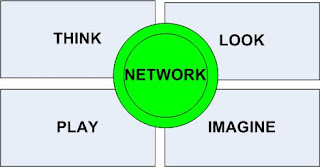The Conference started tonight with a Big Bang:
The Atlanta Drumline! What an incredible performance electrifying the audience doing their “thing.” The pictures were fabulous! Here is one example:
Ahhh that Canon XTi....hummm I am in love! The band was awesome too :)
ISTE President Dr. Trina Davis spoke next. Her message was futuristic, administrative, and thoughtful. She has passionate about equity in the digital age as well as excited about the new National Education Technology Standards for students to meet the challenges of… “today’s increasing digital world” Lastly she reiterated the great international nature of the organization – I thought I hear her say that over 50 nations were represented in this conference! She is quite a lady. Here is a picture of Dr. Davis taken from the ISTE web site:

Andrew Zolli followed Dr. Davis. He was funny yet very enlightening in his message and his view of the future. Andrew is a futurist (a fancy term for a
fortune teller! - just kidding Andrew…) and does well apparently: he is a founder of
Z+Partners where he says that, “Ideas are the currency of the future” He emphasized that everything that can be done with a machine will! The question he then posed was, “
so what are then humans supposed to do to add value?”
What he was basically saying is:
What is it that we (translate our students) will bring to the table? He says…. “only the essence of our creative spirit.” This creativity
will be the new sources of value according to Zolli.
He explained that when new ideas are required we generally use or follow the following model:

Where in the first box – we are asked to produce/desing/invent a product in an isolated “think” mode the failure rate is 85%. While in the “look” box where the person can go out and see what is required the failure rate is 30%. In the “play” box, the product/problem gets redefined but leads to only a 20% failure rate. “Imagine” does not apply because there is no product… (gotcha!) In any case, he went on to expand that the NETWORK model however is much more efficient and produces much less failure – it means that someone who can freely interchange within the four paradigms is more successful...
This to me is important, but it is also a bit of a "duh!" This really should be nothing new to historians... think back about brokerage and leverage and knowledge that can bring things together: treaties, agreements, large concessions, etc... it is always the networked guy that pulls it off!
 He gave another example of the value of networks: originally the value of networks were understood to be value = (# of notes)**2. He says the factor that is missing is participation – the true value is: value = (# of nodes)**”p” Where p=participation. The value is explosive when participation is attained!
He gave another example of the value of networks: originally the value of networks were understood to be value = (# of notes)**2. He says the factor that is missing is participation – the true value is: value = (# of nodes)**”p” Where p=participation. The value is explosive when participation is attained!
He went onto illustrate the demographic transformation of the world and its implications – sobering actually. He outlined the factors of choice vs. complexity and also went on to redefine literacy – as a corollary of all the changes: how will we now “measure” literacy when the world’s knowledge is available on a device available to every student – give them a multiple choice-fill-in-the-bubble test?
He ended with an encouraging note to teachers to understand what is happening around them with themselves and understand their own Biases and Blindness and understand the futures we choose to bring our students.
Excellent keynote address.














 Andrew Zolli followed Dr. Davis. He was funny yet very enlightening in his message and his view of the future. Andrew is a futurist (a fancy term for a fortune teller! - just kidding Andrew…) and does well apparently: he is a founder of
Andrew Zolli followed Dr. Davis. He was funny yet very enlightening in his message and his view of the future. Andrew is a futurist (a fancy term for a fortune teller! - just kidding Andrew…) and does well apparently: he is a founder of 
 He gave another example of the value of networks: originally the value of networks were understood to be value = (# of notes)**2. He says the factor that is missing is participation – the true value is: value = (# of nodes)**”p” Where p=participation. The value is explosive when participation is attained!
He gave another example of the value of networks: originally the value of networks were understood to be value = (# of notes)**2. He says the factor that is missing is participation – the true value is: value = (# of nodes)**”p” Where p=participation. The value is explosive when participation is attained!




